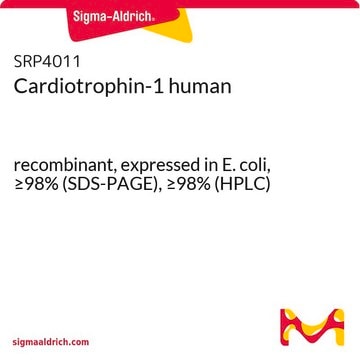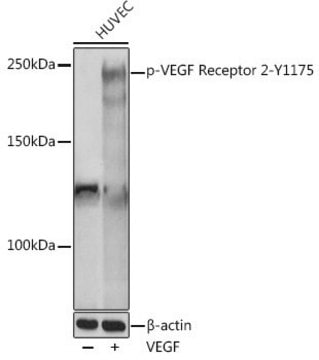V1014
Anti-Vascular Endothelial Growth Factor Receptor 2 antibody produced in goat
affinity isolated antibody, lyophilized powder
동의어(들):
Anti-Flk-1, Anti-VEGF R2
로그인조직 및 계약 가격 보기
모든 사진(1)
About This Item
결합:
unconjugated
application:
FACS
IHC
Neutral
WB
IHC
Neutral
WB
클론:
polyclonal
종 반응성:
mouse
citations:
11
기술:
flow cytometry: 3-10 μg/mL (106 cells)
immunohistochemistry: 5-15 μg/mL using cells and tissues
neutralization: suitable
western blot: 0.1-0.2 μg/mL
immunohistochemistry: 5-15 μg/mL using cells and tissues
neutralization: suitable
western blot: 0.1-0.2 μg/mL
추천 제품
생물학적 소스
goat
Quality Level
결합
unconjugated
항체 형태
affinity isolated antibody
항체 생산 유형
primary antibodies
클론
polyclonal
양식
lyophilized powder
종 반응성
mouse
기술
flow cytometry: 3-10 μg/mL (106 cells)
immunohistochemistry: 5-15 μg/mL using cells and tissues
neutralization: suitable
western blot: 0.1-0.2 μg/mL
UniProt 수납 번호
저장 온도
−20°C
타겟 번역 후 변형
unmodified
유전자 정보
mouse ... Kdr(16542)
일반 설명
Vascular endothelial growth factors receptors (VEGF Rs) are receptor tyrosine kinases that bind to VEGF that plays important role in embryonic vasculogenesis, angiogenesis and homeostasis. VEGF R2 has the ability to form heterodimers with VEGF R1 and VEGF R3. The binding of VEGF to VEGF R2 results in activation of tyrosine amino acids of the cytoplasmic tail of the receptor. This interaction results in the activation of MAPK, PI3K, PKC, FAK and Src kinase pathways. The biological roles of VEGF R2 include in epithelial cell growth, proliferation, survival, migration and vascular permeability and angiogenesis. Due to its role in promoting migration and angiogenesis, VEGF R2 has been implicated in breast and prostate cancer
Anti-Vascular Endothelial Growth Factor Receptor-2 recognizes mouse VEGF R2.
Anti-Vascular Endothelial Growth Factor Receptor-2 recognizes mouse VEGF R2.
특이성
The antibody has the ability to neutralize the biological activity of recombinant mouse VEGF R2. It demonstates approximately 40% cross-reactivity with recombinant human VEGF R2, 2% cross-reactivty with recombinant mouse VEGF R1, and no cross-reactivity with recombinant human VEGF R1 and VEGF R3.
면역원
purified recombinant mouse VEGF R2 extracellular domain expressed in NSO cells.
애플리케이션
Anti-Vascular Endothelial Growth Factor Receptor 2 antibody may be used in immunoblotting at a working concentration of 0.1-0.2 μg/ml. For flow cytometry the recommended concentration is 3-10 μg/ml. The immunohistochemistry of cells and tissues, a working concentration of 5-15 μg/ml may be used. For neutralization reactions, ND50 of 0.1-0.3 μg/ml is recommended.
물리적 형태
Lyophilized from a 0.2 μm filtered solution in phosphate buffered saline containing carbohydrates.
면책조항
Unless otherwise stated in our catalog or other company documentation accompanying the product(s), our products are intended for research use only and are not to be used for any other purpose, which includes but is not limited to, unauthorized commercial uses, in vitro diagnostic uses, ex vivo or in vivo therapeutic uses or any type of consumption or application to humans or animals.
적합한 제품을 찾을 수 없으신가요?
당사의 제품 선택기 도구.을(를) 시도해 보세요.
Storage Class Code
11 - Combustible Solids
WGK
WGK 1
Flash Point (°F)
Not applicable
Flash Point (°C)
Not applicable
개인 보호 장비
Eyeshields, Gloves, type N95 (US)
Shanchun Guo et al.
Biochimica et biophysica acta, 1806(1), 108-121 (2010-05-14)
Investigations over the last decade have established the essential role of growth factors and their receptors during angiogenesis and carcinogenesis. The vascular endothelial growth factor receptor (VEGFR) family in mammals contains three members, VEGFR-1 (Flt-1), VEGFR-2 (KDR/Flk-1) and VEGFR-3 (Flt-4)
P Berger et al.
Swiss medical weekly, 141, w13318-w13318 (2011-12-20)
Vascular endothelial growth factors (VEGFs) regulate blood and lymph vessel formation through activation of the type V receptor tyrosine kinases VEGFR-1, -2 and -3. In addition, VEGFs interact with co-receptors such as neuropilins, integrins, semaphorins or heparansulfate glycosaminoglycans. Ligand binding
Rachel L Padget et al.
Mechanisms of development, 156, 8-19 (2019-02-24)
Blood vessel maturation, which is characterized by the investment of vascular smooth muscle cells (vSMCs) around developing blood vessels, begins when vessels remodel into a hierarchy of proximal arteries and proximal veins that branch into smaller distal capillaries. The ultimate
Nanbing Li-Villarreal et al.
Development (Cambridge, England), 149(7) (2022-03-18)
Establishing a functional circulatory system is required for post-implantation development during murine embryogenesis. Previous studies in loss-of-function mouse models showed that FOXO1, a Forkhead family transcription factor, is required for yolk sac (YS) vascular remodeling and survival beyond embryonic day
Hiroyuki Takahashi et al.
Clinical science (London, England : 1979), 109(3), 227-241 (2005-08-18)
The VEGF (vascular endothelial growth factor) family and its receptors are essential regulators of angiogenesis and vascular permeability. Currently, the VEGF family consists of VEGF-A, PlGF (placenta growth factor), VEGF-B, VEGF-C, VEGF-D, VEGF-E and snake venom VEGF. VEGF-A has at
문서
Cancer stem cell media, spheroid plates and cancer stem cell markers to culture and characterize CSC populations.
자사의 과학자팀은 생명 과학, 재료 과학, 화학 합성, 크로마토그래피, 분석 및 기타 많은 영역을 포함한 모든 과학 분야에 경험이 있습니다..
고객지원팀으로 연락바랍니다.








